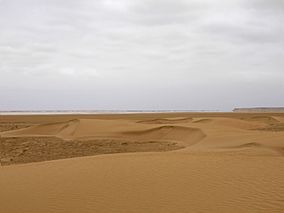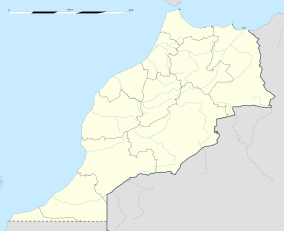Khenifiss National Park facts for kids
Quick facts for kids Khenifiss National Park |
|
|---|---|
|
IUCN Category II (National Park)
|
|

Sand dunes in the park, with the Atlantic Ocean in the background
|
|
| Location | Morocco |
| Nearest city | Tan-Tan, Tarfaya |
| Area | 1,850 square kilometres (710 sq mi) |
| Established | September 26, 2006 |
Khenifiss National Park (French: Le Parc National Khenifiss) is a special nature area in the southwest of Morocco. It is found near Akhfennir on the Atlantic coast. This park was created in 2006 to protect its unique desert, wetlands, and coastal sand dunes. It covers a large area of 1,850 square kilometres (710 sq mi).
The park has an interesting history. It started as a natural reserve in 1960. Later, in 1980, it was recognized as a very important wetland around the world. On September 26, 2006, it officially became a national park.
Contents
Where is Khenifiss National Park?
The park is located right on the coast of the Atlantic Ocean. It is north of the border with Western Sahara. You can find it between the towns of Tan-Tan to the north and Tarfaya to the south. The main road, National Route 1, goes through the park. This road runs along Morocco's Atlantic coast.
What Makes the Park Special?
Khenifiss National Park has two main parts: a coastal area and an inland desert area.
The Khenfiss Lagoon
The coastal part includes the Khenfiss lagoon. This is the largest lagoon on the Moroccan coast. It is a very important place for many birds to nest and live.
Birds of the Lagoon
Many different bird species live in the lagoon. Some, like the ruddy shelduck, marbled duck, and Audouin's gull, stay there all year. A huge number of other birds visit the lagoon in winter. About 20,000 birds come to the lagoon area every winter season. It's like a big bird hotel!
The Inland Desert Area
The inland part of the park looks like a typical Sahara desert. It has flat areas called sabkhas, which are salt flats. You can also see beautiful sand dunes and high limestone plateaus.
Protecting Nature and Tourism
The government wants to make Khenifiss National Park a popular place for visitors. They plan to focus on ecotourism. This means tourism that helps protect nature and supports local communities.
World Heritage Status
This special site was added to the UNESCO World Heritage Tentative List on December 10, 1998. This means it is being considered for official World Heritage status because of its natural importance.
See also
 In Spanish: Parque nacional Khenifiss para niños
In Spanish: Parque nacional Khenifiss para niños


